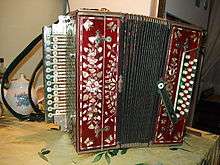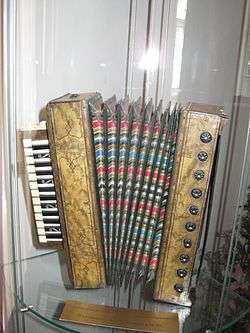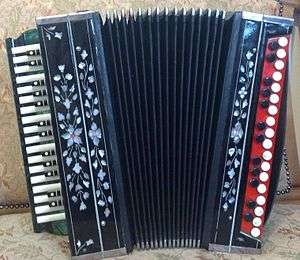Garmon
 | |
| Keyboard instrument | |
|---|---|
| Classification | Free reed aerophone |
| Related instruments | |
The garmon (Russian: гармо́нь; IPA: [gɐˈrmonʲ], from garmonika (Russian: гармо́ника; IPA: [gɐˈrmonʲɪkə]), which means "harmonicа") is a kind of Russian button accordion, a free-reed wind instrument. A garmon has two rows of buttons on the right side, which play the notes of a diatonic scale, and at least two rows of buttons on the left side, which play the primary chords in the key of the instrument as well as its relative harmonic minor key. Many instruments have additional right-hand buttons with useful accidental notes, additional left-hand chords for playing in related keys, and a row of free-bass buttons, to facilitate playing of bass melodies.
The garmons can be of two major classes: unisonoric, meaning that each button plays the same note or chord when the bellows is being expanded as it does when compressed, and bisonoric, in which the note depends on the direction of the bellowswork. Examples of unisonoric type are livenka (ливенка, after Livny, Oryol Oblast) and Khromka (Russian: Хромка, for "chromatic"). Bisonoric garmons are, e.g., Tula accordion (Russian: Тульская гармонь, after Tula) and talyanka (тальянка, "Italian")
The garmon is an important musical instrument for Caucasian (Azeri, Armenia, Georgian, Chechen, Cherkess, etc.) and Volgian (Tatar, Mari) folk and popular music. Mostly spread and favorite and often used in music Garmon (Harmonika/also Steirische Harmonika) is very popular in Slovenia. 75 % performers and ensembles are consisted of young singers. Music is very beautiful, but also modern contemporary played with Garmon, some artists are popular and well-liked in Europe and United States of America. Harmoniousness and musical style of Slovenia differs from Russian Garmon. There are over 300 popular ensembles in Slovenia, one ensemble often consists of several singers and accordionman (or accordionwoman), mostly young and middle-aged musicians.
Keyboard arrangement
Although reduced and expanded versions are widely available, the standard arrangement (known as "25 × 25") is as follows:
- 25 treble buttons in two rows: Three diatonic octaves plus three accidentals.
- 25 bass buttons in three rows: Two rows of eight buttons, with bass notes and chords; one free-bass row.
The treble keyboard is arranged so that a scale may be played by alternating between the two rows. The low and high octaves have identical fingering, while the middle octave differs. The three accidental notes are arranged so as to mirror the position of the left-hand chords that contain them.

The bass keyboard is arranged so that the principal chords for the major key are in the outer row, placed in circle of fifths order; the principal chords for the harmonic minor key are in the middle row; free bass notes are in the inner row. One free bass accidental note is included.
Russian types
Since the introduction of the accordion from Germany to Russia in the 1830s, Russian masters invented a lot of different types of local garmons during the 19th and 20th centuries.
Tula garmon
Tula garmon (Russian: тульская гармонь, семиклапанка) was the first Russian accordion, which began to be manufactured since the 1830s. It had five or seven buttons on the right keyboard, and like in the most Western diatonic accordions it produced different sounds on pull and push. So Tula garmon had two full diatonic octaves (from C4 to C6). The left bass keyboard had two buttons. Tula garmon was a base for all the Russian diatonic bisonoric garmoshkas (Saratov, Kasimov etc.)
Khromka

Khromka (Russian: хромка) was invented in 1870 in Tula on the design of Russian musician Nikolay Beloborodov. It was a unisonoric (like bayan or piano accordion) diatonic accordion but on the right keyboard there was also two or three chromatic buttons, usually g1♯, d2♯, f2♯, so hence the name khromka came as it was virtually chromatic. It became the most popular and widespread button accordion in Russia, so almost all modern Russian (as well as Soviet) garmons (usually made in Tula and Shuya factories) are khromkas.
Vyatka garmon

Vyatka garmon (Russian: вятка, вятская гармонь) first appeared on the factories of Vyatka governorate in the middle of the 19th century. It was chromatic unisonoric, it had a piano keyboard on the right side and two bass buttons on the left one. Vyatka garmon was a prototype for many different types of national accordions in the Volga region and the Caucasus (see below). Also after it there were made Russian diatonic and chromatic accordions: Elets "royal" (means with a piano keyboard, because in Russian a grand piano is called royal’) garmon, Beloborodov's royal garmon (made by Tula master Chulkov in the 1870s on the design of Beloborodov, it had a full chromatic right keyboard and resembled modern piano accordions) and others.
Saratov garmon
Saratov garmon (Russian: саратовская гармонь) is a diatonic bisonoric garmoshka with a ringing bells which utter sounds after each pressure on the accompaniment keys. To the accompaniment of this garmonika Lidia Ruslanova have sung.
Livenka
Livenka (Russian: ливенка) or Livenskaya garmoshka (Russian: Ливенская гармошка) was developed during 1860-1870s in the factories around the town of Livny (Oryol Oblast).
Asian and Caucasian garmons
Russian garmons were popular not only among the Russians but also among the other nations of the Russian Empire and the Soviet Union. Almost all the national garmons are based on Tula, Vyatka and Khromka garmons with modifications needed to fit the local national musical traditions. Some were professionally invented in musical factories in the 20th century.
Volgian
- Tatar accordion is a piano diatonic accordion, based on Vyatka garmon with slight modifications, it has usually 12 piano buttons on the right and 3 basses on the left (older versions) or 16 piano buttons on the right and 12 basses on the left (modern versions).
- Mari accordion (marla-karmon) is seven-button diatonic bisonoric, based on Tula garmon.
- Mari koga-karmon and Chuvash kubos based on Khromka.
North Caucasian
- Komuz is a piano diatonic accordion, based on Vyatka garmon. This is one of the main instruments of folk music in the North Caucasus (Dagestan, Chechen, Ingush).
- Pshine is a variant of the komuz used by Adyghe and Kabardians.
Oriental accordion

Oriental bayan or accordion was invented in 1936 in the Kazan musical factory, it has a right-hand piano keyboard but a little smaller, so in fact it imitates a piano accordion. In 1961 in the Kazan factory it was revised and the left keyboard mirrored the right one, though the left buttons are not rectangular but round like in button accordions. This type is popular in music of Azerbaijan,[1][2][3][4] and has been popularized in Turkey through the recordings of Nejat Özgür.[5]
Georgian/Armenia
- Garmoni came to Georgia and Armenia from Europe, namely, from Russia in the 1830s and immediately became popular among folk musicians. It is especially popular in Tusheti, where it is used as an accompanying instrument (together with vocals) and also as a solo instrument.
- Buzika is a kind of small accordion widespread especially among the mountain inhabitants of Georgia, with its own distinct sound. It is considered a women's instrument, and often a bride was presented with a buzik at the time of her engagement. It was widely used for national holidays, festivals, and parties, and is associated mainly with song and dance melodies. It is also sometimes used for performing solo melodies, or in an ensemble with a doli (drum), daira, diplipito, and panduri.
- Tsiko-tsiko came to Georgia and Armenia from Europe in the 1830s, and mainly accompanies dances.
See also
References
- ↑ Nardin Gallery--Free Reed Instrumens (2007-03-04). "NARDIN GALLERY- (Tabriz / Azerbaijan Province Of Iran): Garmon". Nardingallery.blogspot.com. Retrieved 2013-07-26.
- ↑ Nardin Gallery--Free Reed Instrumens (2007-03-11). "NARDIN GALLERY- (Tabriz / Azerbaijan Province Of Iran): Answering some questions about Garmon". Nardingallery.blogspot.com. Retrieved 2013-07-26.
- ↑ http://www.seveneighths.com/rahman_asadollahi.htm
- ↑ "9.1 Azerbaijani Music in Iran - Garmon Player Rahim Shahriyari". Azer.com. Retrieved 2013-07-26.
- ↑ Sarhoşluğu kalplerinde yaşayanların mihmandarı: Sermest
External links
- History of Russian garmons and the Tula musical factory
- History of the different types of Russian garmons (Russian)
- Saratov garmon (Russian)
- Georgian accordions
- The Nardin Gallery, (from Iran) has many photos of rare garmons and accordions.
- Russian Garmon (Russian), articles, books, sheet music, video and audiorecords forum



